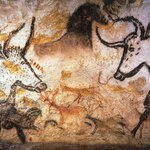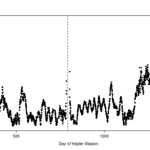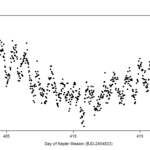Space

Picture this - an astronaut has just found life on Mars. How do you think it happens? I expect most of us will answer "Found a fossil" as in the painting by Pat Rawlings used as the cover for my new kindle book. However, Curiosity is exploring a lake bed that has been dry for three billion years. That's long before there were any easily recognizable fossils on Earth.
Cover of my new kindle book, with detail of Pat Rawlings' painting of an astronaut discovering a fossil on Mars. Most of us are "fossil optimists" when it comes to Mars, without thinking about it. But most of the regions…
If Humans Touch Mars
Will It Be Another Tale Of Human Missteps Like Lascaux?
Copyright © Robert Walker (UK). All rights reserved.
Cover picture shows
First published on December 2016. You can also read this on kindle. For my other kindle booklets, see my author page on Amazon.com
The main sections in this book are
Preface
Contents
Touching Mars
Searching for fossils on Mars in the popular imagination
So how easy or hard will it be to search for life on Mars?
For a clear signal of past life
Nasa's plan for safe zones - based on finding Mars life easily
Methane…
Vera Rubin who helped to discover one of the greatest mysteries of nature has died. She was the mother of astronomical dark matter investigation. I won't write about her accomplishments at length ... plenty has been said about them. In short, she found the first real evidence of dark matter. She found that something we don't understand, and can't detect by any means other than gravity effects the shape of galaxies. She did this as a woman in science and provided a beacon for all people who are not the stereotype of a scientist.
Vera Rubin will…

We love to touch things. If you put a sculpture in an art gallery and say "please touch" you can guarantee that both children and adults will touch it. So it's natural that we want to touch other planets. But there are plenty of things we can't touch on Earth, not just sculptures and works of art in art galleries. The Lascaux cave paintings for instance,
Photograph of the Lascaux paintings by Prof Saxx.
The original painters touched the caves. Many of us would love touch them also, feel the texture of the rock that they were painted over. But not only is nobody permitted to touch them - we…

This is something you hear said so often - that we risk being hit by an asteroid that could make humans extinct. But do we really? This is the article I’m commenting on, a recently breaking news story: Earth woefully unprepared for surprise comet or asteroid, Nasa scientist warns. Some are already worrying that it means that we are all due to die in the near future from an asteroid impact. Well, no, it doesn't mean that. So, what is the truth behind it?
The source of all this is a comment by Dr Joseph Nuth who warns:
“But on the other hand they are the extinction-level events, things…

I had previously discussed the amplitude of the ~0.88-day signal of Boyajian's star (or KIC 8462852.) If you look at the amplitude series alongside gradual dimming of the star throughout the Kepler mission (Montet and Simon, 2016), it appears there's a relationship, even though amplitude changes are real and not an artifact of dimming. Montet dimming is thought to be very unique to Boyajian's star. It follows that if the 0.88-day signal is independent of major dips, our peculiar star happens to be affected by two unique but independent mechanisms. Per Occam's Razor, perhaps we're not…

Data visualization is a key tool in Data Science. You should always look at your data. Invariably, you will discover aspects of the data you might not notice if you just blindly run algorithms on it. That said, another important rule of thumb in Data Science is that you should not only rely on what you think you are seeing. You should always follow up and confirm any graphical analysis with Math.
That should be the lesson of Where's The Fuzz?, a collection of observations and arguments based entirely on graphical analysis, which I recently wrote. As it turns out, much of what we think we see…

The giant planets in our solar system have very diverse rings. Observations show that Saturn’s rings are made of more than 95% icy particles, while the rings of Uranus and Neptune are darker and may have higher rock content. Since the rings of Saturn were first observed in the 17th century, investigation of the rings has expanded from earth-based telescopes to spacecraft such as Voyagers and Cassini. However, the origin of the rings was still unclear and the mechanisms that lead to the diverse ring systems were unknown.
The present study focused on the period called the Late Heavy Bombardment…
If Elon Musk and Robert Zubrin have their way, we may get migrations of hopefuls setting off from Earth to Mars to colonize what they believe to be a "New World". If so, what they find there will be far more like the nineteenth century Antarctica than the seventeenth century "New World". Indeed, even the climbers who tackled Mount Everest in the twentieth century explored a far more hospitable place than Mars. You could breathe the air on the summit with only the need for an oxygen mask. It's also bitterly cold on Mars - a night in the Martian tropics is colder than the coldest night on…

[Update 11/12/2016: Is it all an optical illusion? Read the follow-up.]
[Update 11/7/2016: Visually, fast drops in a time series, like those of D140 and D260, will tend to appear to squash any noise and periodicity. For that reason, analysis of presence of periodicity needs to be mathematical.]
One day it will be clear that the ~0.88-day periodicity of Boyajian's star (which you might know as KIC 8462852) was key to solving one of the most challenging data problems ever encountered. Today I want to focus on one aspect of that periodicity: When it is there and when it is not.
The landmark "WTF…